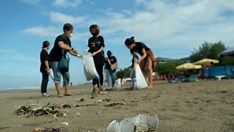
The worldwide flow of man-made chemical and plastic waste has massively exceeded the safe limits for mankind or the planet, and production restrictions are urgently needed. That's the conclusion of scientists for the first time.
It is estimated that there are 350,000 different manufactured chemicals on the market and large volumes of them end up in the environment.
"The impacts we are beginning to see today are large enough to affect important functions of planet Earth and its systems," Bethanie Carney Almroth, one of the authors of the new study, told AFP in an interview.
Chemical and plastic waste affects biodiversity, adding to stress on already stressed ecosystems. Pesticides kill living organisms indiscriminately and plastic is ingested by living things.
While greater efforts are needed to prevent these substances from being released into the environment, scientists are now pushing for more drastic solutions, such as production restrictions.
Recycling so far has yielded mediocre results. Less than 10 percent of the world's plastic is currently recycled, even as production has more than doubled to 367 million tonnes since 2000.

Today, the total weight of plastic on Earth is now four times the biomass of all living animals, according to recent research.
For several years, the Stockholm Center for Resilience conducted studies of the planet's boundaries in nine areas that affect Earth's stability, such as greenhouse gas emissions, freshwater use, and the ozone layer.
The goal is to determine if humanity is in a safe operating room or if its limits are crossed and threaten the future of the planet.
The impact of so-called new entities or man-made chemical products such as plastics, antibiotics, pesticides and non-natural metals - is still a big question.
Not only are there thousands of these products, but data about the risks they pose are often either missing or classified as company secrets.
Even the most comprehensive databases, such as the EU's REACH inventory, cover only 150,000 products, and only a third of those products are the subject of detailed toxicity studies.
As a result, the research team focused on what was known, and this partial information was sufficient to draw worrying conclusions.
"Looking at changes over time and trends in lost production volumes in the environment and relating them to what little we know about impact, we can safely say that every arrow is pointing in the wrong direction," said Carney Almroth.
There is still "time to restore this situation" but will take "urgent and ambitious action ... at the international level", he added.
Regardless of how much effort is put into the production or waste management phase, production volumes need to be reduced.